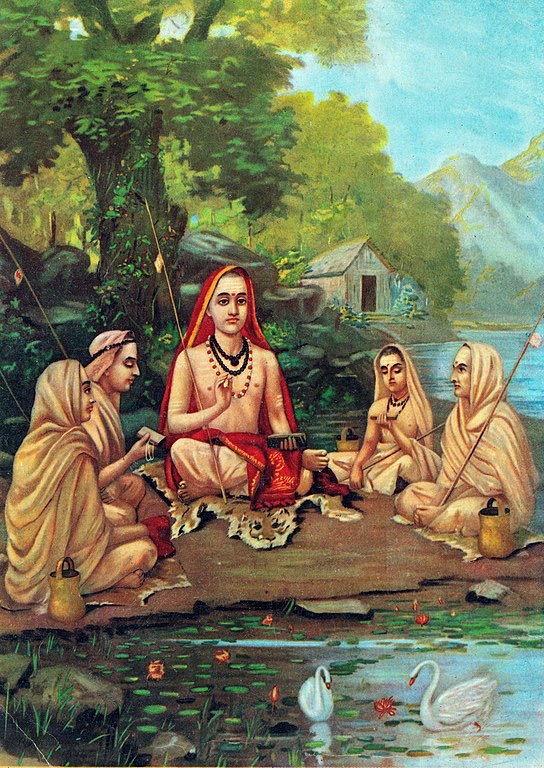‘Adi Shankara and his disciples’ – by Raja Ravi Varma, 1904 – Wikimedia
.
अहं निर्विकल्पो निराकार रूपो,
विभुत्वाच सर्वत्र सर्वेन्द्रियाणाम् ।
न चासङ्गतं नैव मुक्तिर्न मेयः,
चिदानन्दरूपः शिवोऽहम् शिवोऽहम् ।
ahaṃ nirvikalpo nirākāra rūpo
vibhutvā ca sarvatra sarvendriyāṇaṃ |
na cāsaṅgataṃ naiva muktir na meyaḥ
cidānandarūpaḥ śivo’ham śivo’ham |
.
The early spiritual works produced in India were anonymous, probably stated by some ancient sages whose identities got lost. There is one name though that rose and was brought to fame and excellence, a teacher whose life has been narrated in many hagiographies and legends. His name: Adi Shankara, or Shankaracharya. His work as a philosopher and religious reformer is considered prominent in the unfolding of Hinduism. He is also known for having formulated and codified the ancient spiritual current of Non-duality, called in India Advaita Vedanta.
India’s most celebrated teacher was born in Kerala, in a village called Kaladi, in the accepted year of 788. Everything is uncertain about Shankara, since his numerous biographies were written centuries after his death and were designed to build a legend around his life. The name ‘Shankaracharya’ means the teacher ‘acharya’ of the way to bring about happiness (‘sham’ means ‘auspicious’ and ‘kara’ ‘maker’). He died at the early age of 32. A short life that nevertheless allowed him to travel widely all over India, initiating debates, founding monasteries ‘Matha’, and writing numerous pieces of work among which commentaries of ancient texts like the Brahma Sutras, the Bhagavad Gita, or the Principal Upanishads.
Amongst the many works authentically attributed to him is the Atmashatkam, also known as Nirvanashatkam. The legend says that Shankara, aged only eight at the time, wrote this devotional poem of six slokas as an answer to his newly found guru Govindapada who asked him the simple question “Who are you?”. This is a very striking and moving exposition of everything that we are not, everything that has been wrongly attributed as being our identity. Through experientially discarding every such thing, one comes to dawn on the simple realisation of our true nature, namely the Self or, as it is named in this translation, ‘the auspicious, love and pure consciousness’. This was concluding each stanza in the original Sanskrit as ‘I am Shiva! I am Shiva!’ (Shivoham)…
I am not mind, nor intellect, nor ego,
nor the reflections of inner self.
I am not the five senses. I am beyond that.
I am not the seven elements or the five sheaths.
I am indeed, That eternal knowing and bliss,
the auspicious, love and pure consciousness.
[…]
A discovery of the ancient teachings of Adi Shankara… (READ MORE…)
.


Reblogged this on Gathering of Wisdom.
LikeLiked by 1 person
I first heard Nirvanashatakam in the mid 90s, when i was doing yoga at a friend’s home on a coffee estate in the hills of southern india. It is the one song that says everything there is to say. I have been singing it ever since. It is the warm blanket of truth that protects us
LikeLiked by 2 people
How wonderful to be able to sing it Ananda! I find it a very touching piece. Thank you for your comment. 🙏
LikeLiked by 1 person